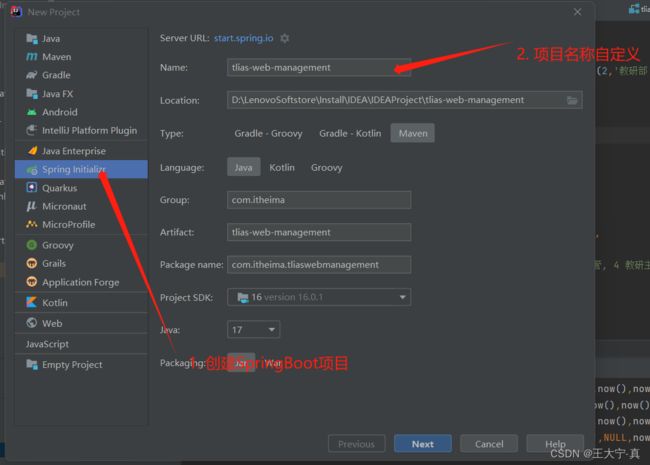Java—基于SpringBootWeb的综合小案例(智能学习辅助系统)
简介:这篇帖子是小编在看哔哩哔哩网课是的一个小案例,来自于黑马程序员,我觉得他们的课讲的很好,而且这个案例很有实用性,就在看视频的基础上,边温故知新,边实现了这个代码,在一些重点、难点和在编码过程中容易出问题的地方上进行了标注、做详解。
一、准备工作
01、需求&环境搭建
需求说明:(如下图)
环境搭建:在这篇帖子中,因为小编主攻的是后端开发工程师,所以前端工程的项目代码这边直接给出了“百度网盘:前端代码”,大家点击下载就好。(如下图)展示的是一个小项目的过程。
接下来是项目的创建过程:
首先第一步是创建数据库表(下图第一张是源代码,第二张时操作引导)
(指导图片:源代码图片)
-- 部门管理
create table dept(
id int unsigned primary key auto_increment comment '主键ID',
name varchar(10) not null unique comment '部门名称',
create_time datetime not null comment '创建时间',
update_time datetime not null comment '修改时间'
) comment '部门表';
insert into dept (id, name, create_time, update_time) values(1,'学工部',now(),now()),(2,'教研部',now(),now()),(3,'咨询部',now(),now()), (4,'就业部',now(),now()),(5,'人事部',now(),now());
-- 员工管理(带约束)
create table emp (
id int unsigned primary key auto_increment comment 'ID',
username varchar(20) not null unique comment '用户名',
password varchar(32) default '123456' comment '密码',
name varchar(10) not null comment '姓名',
gender tinyint unsigned not null comment '性别, 说明: 1 男, 2 女',
image varchar(300) comment '图像',
job tinyint unsigned comment '职位, 说明: 1 班主任,2 讲师, 3 学工主管, 4 教研主管, 5 咨询师',
entrydate date comment '入职时间',
dept_id int unsigned comment '部门ID',
create_time datetime not null comment '创建时间',
update_time datetime not null comment '修改时间'
) comment '员工表';
INSERT INTO emp
(id, username, password, name, gender, image, job, entrydate,dept_id, create_time, update_time) VALUES
(1,'jinyong','123456','金庸',1,'1.jpg',4,'2000-01-01',2,now(),now()),
(2,'zhangwuji','123456','张无忌',1,'2.jpg',2,'2015-01-01',2,now(),now()),
(3,'yangxiao','123456','杨逍',1,'3.jpg',2,'2008-05-01',2,now(),now()),
(4,'weiyixiao','123456','韦一笑',1,'4.jpg',2,'2007-01-01',2,now(),now()),
(5,'changyuchun','123456','常遇春',1,'5.jpg',2,'2012-12-05',2,now(),now()),
(6,'xiaozhao','123456','小昭',2,'6.jpg',3,'2013-09-05',1,now(),now()),
(7,'jixiaofu','123456','纪晓芙',2,'7.jpg',1,'2005-08-01',1,now(),now()),
(8,'zhouzhiruo','123456','周芷若',2,'8.jpg',1,'2014-11-09',1,now(),now()),
(9,'dingminjun','123456','丁敏君',2,'9.jpg',1,'2011-03-11',1,now(),now()),
(10,'zhaomin','123456','赵敏',2,'10.jpg',1,'2013-09-05',1,now(),now()),
(11,'luzhangke','123456','鹿杖客',1,'11.jpg',5,'2007-02-01',3,now(),now()),
(12,'hebiweng','123456','鹤笔翁',1,'12.jpg',5,'2008-08-18',3,now(),now()),
(13,'fangdongbai','123456','方东白',1,'13.jpg',5,'2012-11-01',3,now(),now()),
(14,'zhangsanfeng','123456','张三丰',1,'14.jpg',2,'2002-08-01',2,now(),now()),
(15,'yulianzhou','123456','俞莲舟',1,'15.jpg',2,'2011-05-01',2,now(),now()),
(16,'songyuanqiao','123456','宋远桥',1,'16.jpg',2,'2007-01-01',2,now(),now()),
(17,'chenyouliang','123456','陈友谅',1,'17.jpg',NULL,'2015-03-21',NULL,now(),now());
(知道图片:操作引导)
接下来是创建SpringBoot项目,并且添加相关依赖,操作引导如下图。
(引导图一)
(引导图二)
(引导图三)
(以上图片中对应的项目代码,大家下载后直接导入就好,点击下载。但是注意要把项目中“application.properties”文件的数据库名称和密码换成自己的。)
02、开发规范
当前主流的开发规范就是前后端分离开发,前端与后端通过阅读接口文档相互约定规则后进行开发。(如下图所示)
编码规则—ResultFul:(如下图所示)
规定一个返回规则:通过定义一个Result类,制定统一的返回结果(如下图所示)
代码详情如下:
package com.itheima.tliaswebmanagement.pojo;
import lombok.AllArgsConstructor;
import lombok.Data;
import lombok.NoArgsConstructor;
@Data
@NoArgsConstructor
@AllArgsConstructor
public class Result {
private Integer code; //响应码: 1. 代表成功 2. 代表失败
private String msg; //响应信息: 描述字符串
private Object data; //返回的数据
public static Result success(){ // 增删改 成功响应
return new Result(1, "success", null);
}
public static Result success(Object data){ // 查询 成功响应
return new Result(1, "success", data);
}
public static Result error(String msg){ // 失败响应
return new Result(0, msg, null);
}
}
二、部门管理
01、查询部门
整体思路“如下图”:首先是浏览器端发送的请求被Controller接收—>将请求发送至Service层进行逻辑处理—>处理后发送到Mapper层访问数据库—>数据库将响应的结果返回给Mapper层—>Mapper层返回给Service层—>Service层返回给Controller层—>Controller层返回给浏览器。
02、前后端联调试
前后端联调指的是将前端工程,后端工程都启动起来,通过前端工程来访问后端工程,进而进行调试。
这边小编已经将前端工程项目上传到我的网盘中,大家(点击下载),并且将其解压缩,然后运行nginx.exe可执行文件就好。
之后使用浏览器访问http://localhost:90。
03、删除部门
此功能是通过点击前端的删除部门按钮,将数据库中的对应部门数据删除掉(如下配图)。
04、新增部门
此功能是通过点击前端的新增部门按钮,将数据库中的对应部门数据增加一条(如下配图)
05、部分核心代码展示(详情代码在下面的最终代码展示)
Controller页面
package com.itheima.tliaswebmanagement.controller;
import com.itheima.tliaswebmanagement.pojo.Dept;
import com.itheima.tliaswebmanagement.pojo.Result;
import com.itheima.tliaswebmanagement.service.DeptService;
import lombok.extern.slf4j.Slf4j;
import org.slf4j.Logger;
import org.slf4j.LoggerFactory;
import org.springframework.beans.factory.annotation.Autowired;
import org.springframework.web.bind.annotation.*;
import java.util.List;
@RestController
@Slf4j
// 一个完整的请求路径,应该是类上的@RequestMapping的value属性+方法上的@RequestMapping的value属性。
@RequestMapping("/depts")
public class DeptController {
@Autowired
private DeptService deptService;
// 获取日志对象
//private static Logger logger = LoggerFactory.getLogger(DeptController.class);
/*@RequestMapping(value = "/depts", method = RequestMethod.GET)*/
/**
* 遍历部门数据
* @return
*/
@GetMapping()
public Result list(){
/*logger.info("通过日志工厂,获取的日志对象: " + );*/
log.info("查询全部部门数据");
List deptList = deptService.list();
return Result.success(deptList);
}
/**
* 根据id删除部门
* @return
*/
@DeleteMapping("/{id}")
public Result deleteByID(@PathVariable Integer id){
log.info("根据部门ID删除部门:{}", id);
deptService.deleteByID(id);
return Result.success();
}
/**
* 向部门插入数据
* @return Result
*/
@PostMapping()
public Result insert(@RequestBody Dept dept){
log.info("新增部门: {}", dept);
deptService.insert(dept);
return Result.success();
}
}
Service层
package com.itheima.tliaswebmanagement.service.impl;
import com.itheima.tliaswebmanagement.mapper.DeptMapper;
import com.itheima.tliaswebmanagement.pojo.Dept;
import com.itheima.tliaswebmanagement.service.DeptService;
import org.springframework.beans.factory.annotation.Autowired;
import org.springframework.stereotype.Service;
import java.time.LocalDateTime;
import java.util.List;
@Service
public class DeptServiceImpl implements DeptService {
@Autowired
private DeptMapper deptMapper;
@Override
public List list() {
return deptMapper.list();
}
@Override
public void deleteByID(Integer id) {
deptMapper.deleteByID(id);
}
@Override
public void insert(Dept dept) {
//补全Dept表中的时间属性
dept.setCreateTime(LocalDateTime.now());
dept.setUpdateTime(LocalDateTime.now());
deptMapper.insert(dept);
}
}
Dao层
package com.itheima.tliaswebmanagement.mapper;
import com.itheima.tliaswebmanagement.pojo.Dept;
import org.apache.ibatis.annotations.Delete;
import org.apache.ibatis.annotations.Insert;
import org.apache.ibatis.annotations.Mapper;
import org.apache.ibatis.annotations.Select;
import java.util.List;
/**
* 部门管理
*/
@Mapper
public interface DeptMapper {
/**
* 查询全部部门数据
* @return
*/
@Select("select * from dept")
List list();
/**
* 通过部门ID删除部门
* @param id
*/
@Delete("delete from dept where id = #{id}")
void deleteByID(Integer id);
/**
* 向部门表插入一个数据
* @param id
*/
@Insert("insert into dept(name, create_time, update_time ) values(#{name}, #{createTime}, #{updateTime})")
void insert(Dept dept);
}
三、员工管理
01、分页查询
此功能是通过点击前端的查询员工按钮,将数据库中的对应员工数据按照约定的格式返回给前端(如下配图)
在项目前端中就能看到我们从数据库中查到的员工数据如下。
小结如下:
02、条件分页查询
这里主要的的难点在于将SQL查询语句统一书写到XMl文件中。如下图所示,在这里使用了动态SQL语句,用以实现条件查询。
03、删除员工
这里主要是通过动态SQL实现批量删除员工表中的员工信息,这里只展示一些核心代码,最终完整项目在文章底部提供链接。
Controller层
package com.itheima.tliaswebmanagement.controller;
import com.itheima.tliaswebmanagement.pojo.PageBean;
import com.itheima.tliaswebmanagement.pojo.Result;
import com.itheima.tliaswebmanagement.service.EmpService;
import lombok.extern.slf4j.Slf4j;
import org.springframework.beans.factory.annotation.Autowired;
import org.springframework.format.annotation.DateTimeFormat;
import org.springframework.web.bind.annotation.*;
import java.time.LocalDate;
import java.util.List;
/**
* 员工管理类
*/
@Slf4j
@RestController
@RequestMapping("/emps")
public class EmpController {
@Autowired
private EmpService empService;
/**
* 员工管理-分页查询
* @param page 页码
* @param pageSize 每页多少数据
*/
@GetMapping()
public Result page(@RequestParam(defaultValue = "1") Integer page, @RequestParam(defaultValue = "10") Integer pageSize,
String name, Short gender,
@DateTimeFormat(pattern = "yyyy-MM-dd") LocalDate begin,
@DateTimeFormat(pattern = "yyyy-MM-dd") LocalDate end){
PageBean pageBean = empService.page(page, pageSize, name, gender, begin, end);
log.info("分页查询参数: {},{},{}, {}, {}", page, pageSize, name, gender, begin, end);
return Result.success(pageBean);
}
/**
* 员工管理-删除员工数据
* @param
* @return
*/
@DeleteMapping("/{ids}")
public Result deleteById(@PathVariable List ids){
log.info("要删除员工数据id: {}", ids);
empService.deleteById(ids);
return Result.success();
}
}
Service层
package com.itheima.tliaswebmanagement.service;
import com.itheima.tliaswebmanagement.pojo.PageBean;
import org.springframework.format.annotation.DateTimeFormat;
import java.time.LocalDate;
import java.util.List;
/**
* 员工管理
*/
public interface EmpService {
/**
* 分页查询
* @param page
* @param pageSize
* @return
*/
PageBean page(Integer page, Integer pageSize, String name, Short gender, LocalDate begin, LocalDate end);
/**
* 根据id删除用户
*/
void deleteById(List ids);
}
Dao层
package com.itheima.tliaswebmanagement.mapper;
import com.itheima.tliaswebmanagement.pojo.Emp;
import org.apache.ibatis.annotations.Mapper;
import org.apache.ibatis.annotations.Select;
import java.time.LocalDate;
import java.util.List;
/**
* 员工管理
*/
@Mapper
public interface EmpMapper {
// 以下代码是使用PageHelper插件进行增删查改的代码。
/**
* 查询员工表所有数据
* @return
*/
/* @Select("select * from emp")*/
public List list(String name, Short gender, LocalDate begin, LocalDate end);
/**
* 根据id删除用户
*/
void deleteById(List ids);
// 以下代码是不使用PageHelper插件进行增删查改的代码。
/* *//**
* 查询消息记录数
* @return
*//*
@Select("select count(*) from emp")
public Long count();
*//**
* 分页查询,获取列表数据
* @return
*//*
@Select("select * from emp limit #{page}, #{pageSize}")
List page(Integer page, Integer pageSize);*/
}
XML配置文件。
delete from emp
id in
#{id}
总结:因为只是一个小项目,而且后面的功能要么就是简单的重复操作,要么就是更深层次的技术点,例如账号管理(注册、登录等),这个小编打算作为单独的一个文章讲解,所以目前为止只提供这么多讲解,如果继续文章就太杂乱了。
这边也建议如果打算想更深层次的学习,可以去哔哩哔哩里面系统的观看他们的网课,然后有不懂得问题或者BUG可以随时给我留言,会非常热心的给出解答,甚至如果出现多人问同一问题,我这边也能在写一篇帖子做解答。
小编的QQ:2917281717
希望大家给个点赞、留言、关注,你的认可就是我坚持下去的动力。
项目的百度链接如下(点击下载)。
















